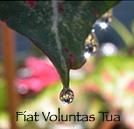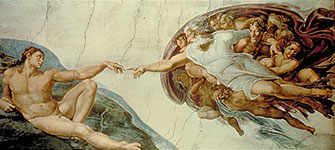



 |
||||||
| Newsletters Spring Newsletter, 2005 Volume 2, Issue 2
|
||||||
|
The Supreme Sacrament
To understand the Eucharist, we must begin with a clear understanding of the sacraments in general. A sacrament is a sign of God's action. But unlike other signs that we are familiar with, such as stop signs or billboards, the sacraments do not only represent or symbolize information from God, they actually "contain and bring about the very thing they signify." 1 The sacramental world is neither physical nor spiritual. It is a totally different reality. The sacraments are "tools in the hands of Christ." 2 They are what we call instrumental; they have the power to effect change. This power has its source in faith, which is contact with God. We know from the gospels that with faith the size of a mustard seed, we can move mountains. But we need help to increase our faith, and we can get that help from the sacraments. They render faith more efficacious, like an amplifier that makes a person's speech more clear and understandable. Without faith, the sacraments are powerless, just as an amplifier does nothing if it is not connected to a speaker's microphone. But together with faith, the sacraments amplify and strengthen our contact with God. The Difference between signs and symbols The difference between a sign and a symbol can be explained with a medical example. The stethoscope is a symbol of a doctor or medical care. The stethoscope alone has no power to diagnose or treat. It only symbolizes medical care. But the stethoscope in the hands of a doctor is a sign. Now it not only symbolizes medical care, but can actually help bring it about; the sign is a symbol joined with its principal cause, which in this case is the doctor. The sacraments are joined with their principal cause, God, which gives them the power to bring about the thing they symbolize. What the Eucharist symbolizes is our sanctification. And it not only symbolizes this, but since as a sacramental sign it is joined with it's principal cause, Christ, it has the power to bring it about. In the Eucharist is the real presence of Christ, not only at the present moment, but also in the past and future. The past suffering and death of Christ on the cross is contained in the Eucharist; His present outpouring of grace into the recipient soul is within the Eucharist; and the future glory of our eternal life with Him is also present in the Eucharist. During adoration, we should remember these three aspects of the real presence. Like Mary and John, we are at the foot of the cross looking upon Christ crucified; like the ailing woman we are touching the hem of His garment to be healed, and like Peter, John and James on Mount Tabor, we are getting a glimpse of our future glory with Him in eternity. "All Glory and Honor is Yours"
Newsletters:
Copyright © 2005 A Drop of Clear Water |
||||||